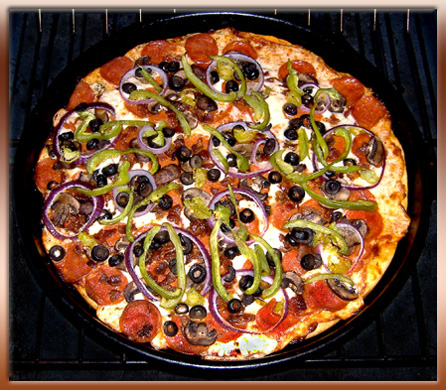


I was raised in Upstate New York. Thin crust pizza was very popular. New York City is famous for their thin crust pizza. On the other hand, Chicago is famous for their thicker crust deep dish pizza. Thick crust vs. thin crust is all about personal taste. Producing a thick crust vs. thin crust pizza is about how and when you make the dough. I have had people ask me for my secret dough recipe. Dough is dough. There is no secret to dough. Dough is flour and water and yeast and salt and maybe some oil and maybe some seasoning.
Yeast baking is a craft. There are a number of variables in making pizza. The type of flour used makes a big difference. The temperature of the dough making and storage are variables. The amount and type of yeast are variables. The time from mixing and kneading till the pizza is put into the hot oven is a variable. All variables relate to the type of oven used. There are many types of commercial ovens and then there is the basic home oven. The amount of oil used to coat the pan, whether or not a corn meal coating is used and the temperature of the oven are all variables. Whether you use a pan at all is based on the type of commercial oven and whether or not you use a stone and peel in a home oven. There are many variables. You have choices based on your hardware - the oven, pan, stone, etc.
It's really not that complicated. You get what you get. I advise people going into the pizza business to start with the oven. The pizza you will be serving is based on your choice of oven type and size. Home ovens are home ovens. Gas vs. electric does not matter. Commercial ovens run a lot hotter than home ovens and may heat up to 800 degrees. They are really hot because they need to serve customers fast. Home ovens don't need to get that hot because we can wait a little longer for our pizza.
Back to thick vs. thin. In a commercial operation it's all based on work flow. Same thing goes at home. A lot of pizza shops don't make their own dough. They buy their dough. It shows up once a day in the morning in trays with lids holding six balls of dough. Shops that do make their own dough make it once a day early and store the dough for later use in the same trays. When it's time to make a pizza they take a ball of dough and press it out on a pan or hand toss it or just spread it out by hand and put on the ingredients and into the oven. The work flow I have just described generally produces a thin crust pizza. The yeast in the dough becomes partially played out over time and therefore the dough won't rise that much in the oven. To make thin crust at home I make my dough in the morning and let it sit in the fridge all day before I make my pizza. If I wait till the next day I will get a really thin crust pizza. Some pizza shops keep dough for a few days. These are thin crust operations.
I call thin crust default pizza because a novice who does not know how to work with yeast and does not activate the yeast properly will end up with a thin crust pizza and very happy - by default. When I make thick crust pizza, I use freshly made dough. I prefer thicker crust pizza. It's just that simple and it's faster to make at home. I make the dough, make the pizza, eat the pizza - no waiting.
For pizza shops it's about work flow and marketing. There was an advertising battle going between two really large pizza chains. One claimed to have fresh dough, the other aged dough. It went to court and they are probably still fighting now. No way of making dough is better than another. It's based on personal taste and the work flow of the operation. You can make either thin crust or thick crust at home in a home oven. It's all about personal taste. It's also about knowing the craft of yeast baking. If you don't know the craft, you will produce thin crust pizza by default.
videobread@gmail.com